Audit Report: Identifying and Assessing Risks at Woolworths Limited
VerifiedAdded on 2020/02/19
|24
|5059
|373
Report
AI Summary
This assignment is an audit report analyzing Woolworths Limited, a major Australian retail organization. It begins with an executive summary and an introduction outlining the report's objectives. The report delves into understanding the nature of Woolworths, its industry, including size, growth, supply chain, major players, market shares, critical success factors, and major threats. It also examines the legal environment and external environmental factors through PEST, SWOT, and Porter's Five Forces analyses. Furthermore, the report assesses Woolworths' objectives, strategies, and business risks, including industry developments, new products, expansion, and regulatory requirements. Analytical procedures, such as liquidity, profitability, efficiency, capital structure, and market performance ratio analyses, are conducted to understand the entity's financial performance. The report concludes with an examination of management and governance aspects, including integrity, competence, organizational structure, and human resource policies. References and appendices are included to support the analysis.
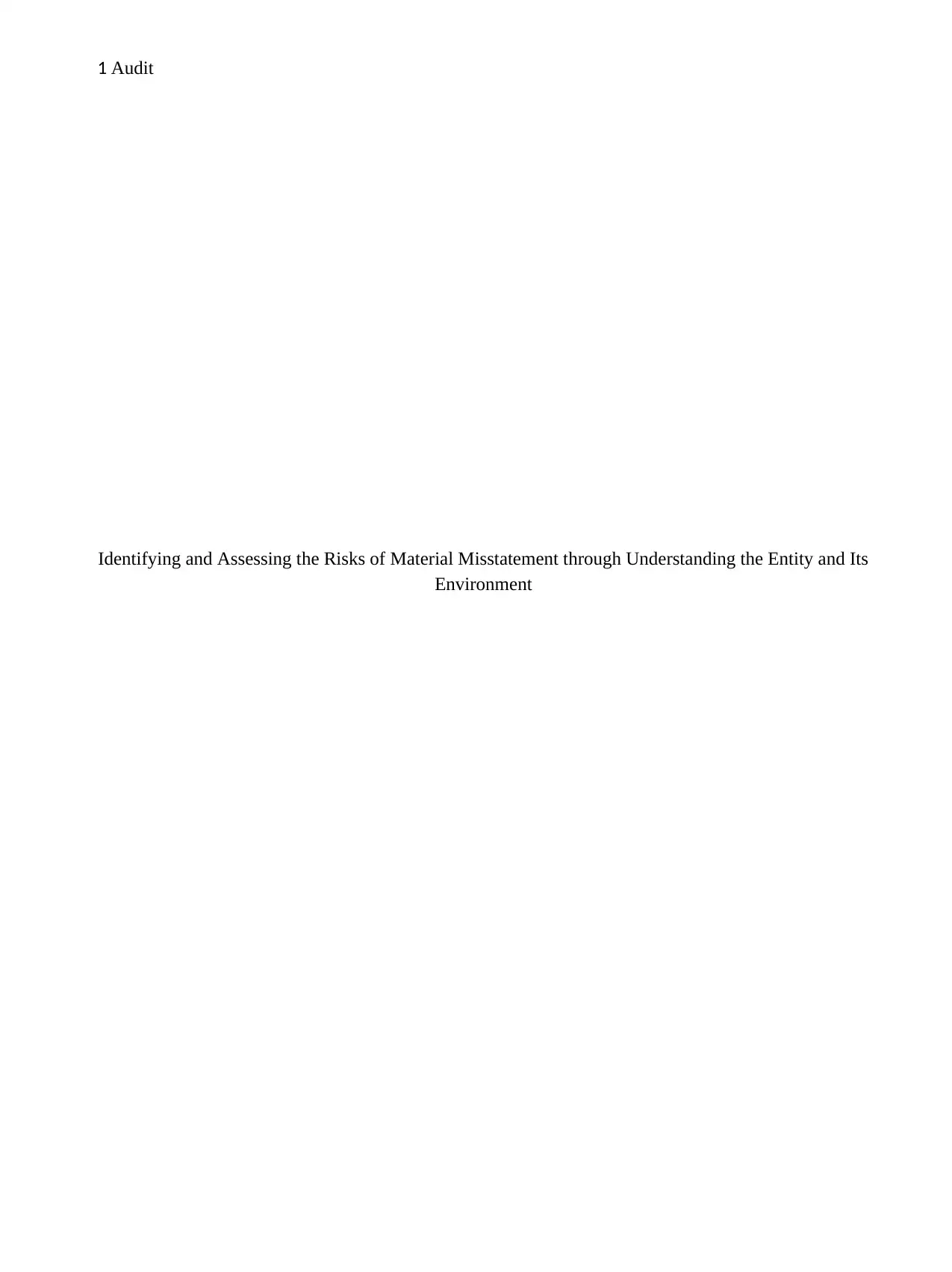
1 Audit
Identifying and Assessing the Risks of Material Misstatement through Understanding the Entity and Its
Environment
Identifying and Assessing the Risks of Material Misstatement through Understanding the Entity and Its
Environment
Paraphrase This Document
Need a fresh take? Get an instant paraphrase of this document with our AI Paraphraser
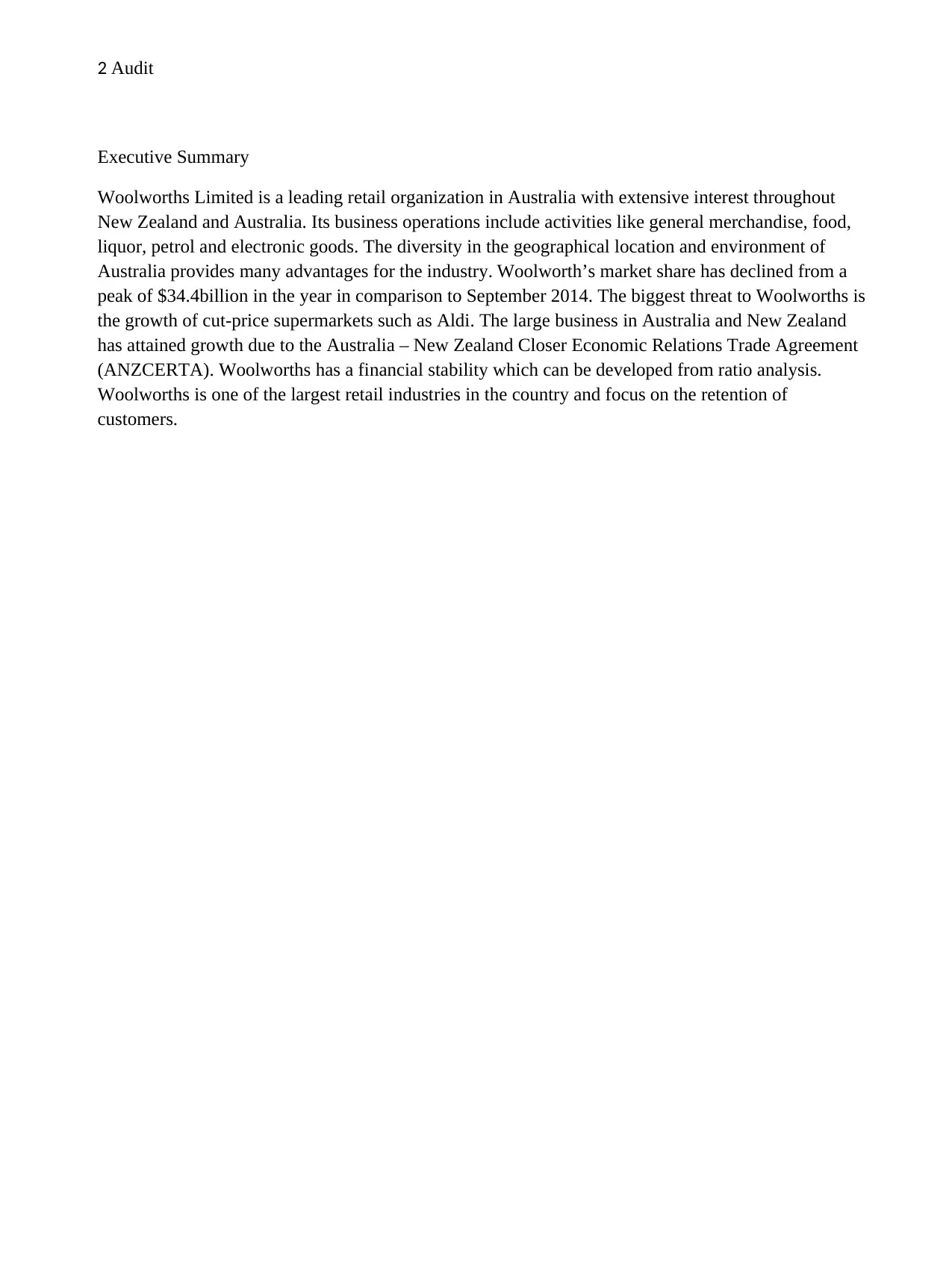
2 Audit
Executive Summary
Woolworths Limited is a leading retail organization in Australia with extensive interest throughout
New Zealand and Australia. Its business operations include activities like general merchandise, food,
liquor, petrol and electronic goods. The diversity in the geographical location and environment of
Australia provides many advantages for the industry. Woolworth’s market share has declined from a
peak of $34.4billion in the year in comparison to September 2014. The biggest threat to Woolworths is
the growth of cut-price supermarkets such as Aldi. The large business in Australia and New Zealand
has attained growth due to the Australia – New Zealand Closer Economic Relations Trade Agreement
(ANZCERTA). Woolworths has a financial stability which can be developed from ratio analysis.
Woolworths is one of the largest retail industries in the country and focus on the retention of
customers.
Executive Summary
Woolworths Limited is a leading retail organization in Australia with extensive interest throughout
New Zealand and Australia. Its business operations include activities like general merchandise, food,
liquor, petrol and electronic goods. The diversity in the geographical location and environment of
Australia provides many advantages for the industry. Woolworth’s market share has declined from a
peak of $34.4billion in the year in comparison to September 2014. The biggest threat to Woolworths is
the growth of cut-price supermarkets such as Aldi. The large business in Australia and New Zealand
has attained growth due to the Australia – New Zealand Closer Economic Relations Trade Agreement
(ANZCERTA). Woolworths has a financial stability which can be developed from ratio analysis.
Woolworths is one of the largest retail industries in the country and focus on the retention of
customers.
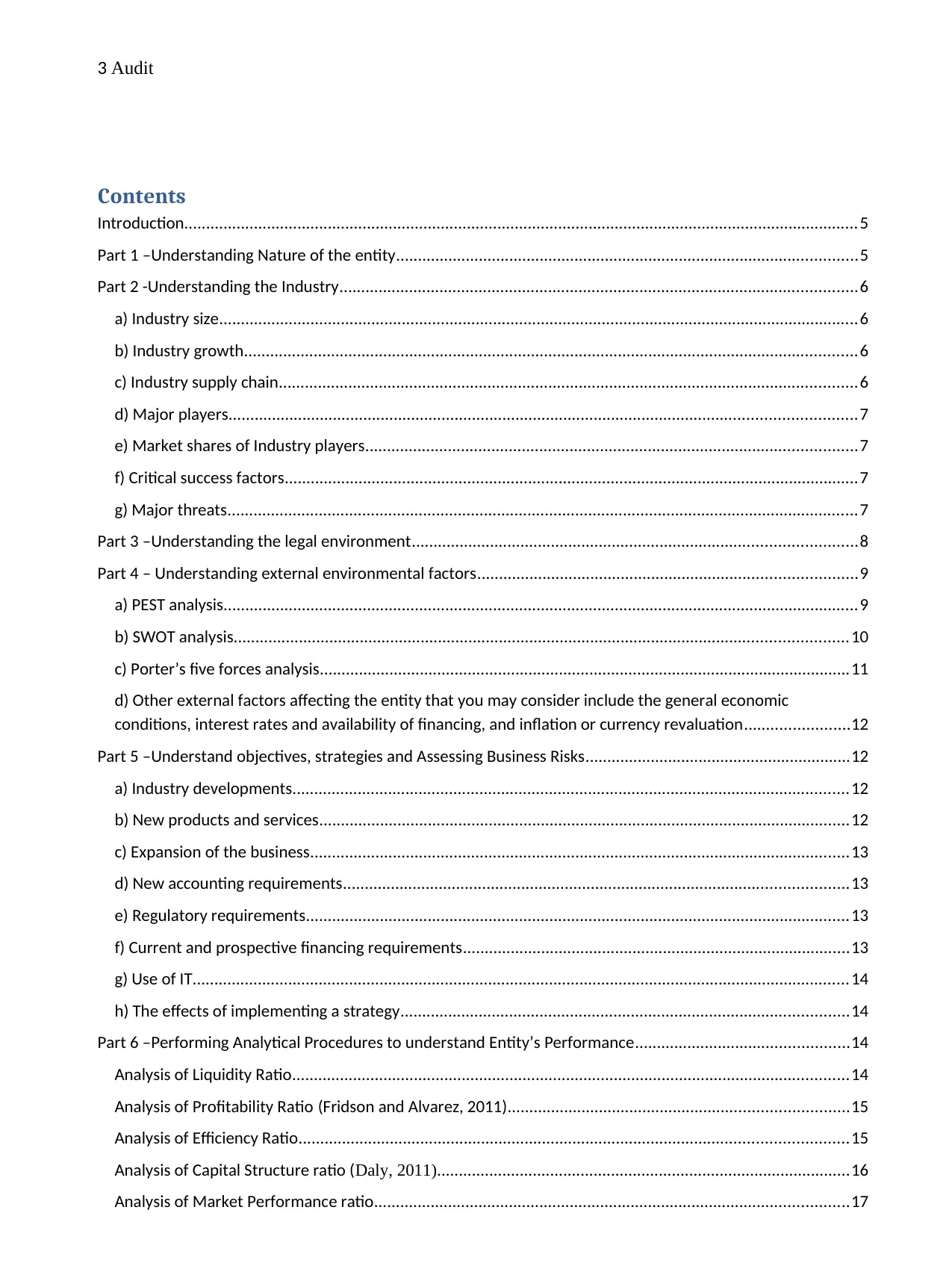
3 Audit
Contents
Introduction...........................................................................................................................................................5
Part 1 –Understanding Nature of the entity..........................................................................................................5
Part 2 -Understanding the Industry.......................................................................................................................6
a) Industry size...................................................................................................................................................6
b) Industry growth.............................................................................................................................................6
c) Industry supply chain.....................................................................................................................................6
d) Major players................................................................................................................................................7
e) Market shares of Industry players.................................................................................................................7
f) Critical success factors....................................................................................................................................7
g) Major threats.................................................................................................................................................7
Part 3 –Understanding the legal environment......................................................................................................8
Part 4 – Understanding external environmental factors.......................................................................................9
a) PEST analysis..................................................................................................................................................9
b) SWOT analysis.............................................................................................................................................10
c) Porter’s five forces analysis..........................................................................................................................11
d) Other external factors affecting the entity that you may consider include the general economic
conditions, interest rates and availability of financing, and inflation or currency revaluation........................12
Part 5 –Understand objectives, strategies and Assessing Business Risks.............................................................12
a) Industry developments................................................................................................................................12
b) New products and services..........................................................................................................................12
c) Expansion of the business............................................................................................................................13
d) New accounting requirements....................................................................................................................13
e) Regulatory requirements.............................................................................................................................13
f) Current and prospective financing requirements.........................................................................................13
g) Use of IT.......................................................................................................................................................14
h) The effects of implementing a strategy.......................................................................................................14
Part 6 –Performing Analytical Procedures to understand Entity’s Performance.................................................14
Analysis of Liquidity Ratio................................................................................................................................14
Analysis of Profitability Ratio (Fridson and Alvarez, 2011)..............................................................................15
Analysis of Efficiency Ratio..............................................................................................................................15
Analysis of Capital Structure ratio (Daly, 2011)...............................................................................................16
Analysis of Market Performance ratio.............................................................................................................17
Contents
Introduction...........................................................................................................................................................5
Part 1 –Understanding Nature of the entity..........................................................................................................5
Part 2 -Understanding the Industry.......................................................................................................................6
a) Industry size...................................................................................................................................................6
b) Industry growth.............................................................................................................................................6
c) Industry supply chain.....................................................................................................................................6
d) Major players................................................................................................................................................7
e) Market shares of Industry players.................................................................................................................7
f) Critical success factors....................................................................................................................................7
g) Major threats.................................................................................................................................................7
Part 3 –Understanding the legal environment......................................................................................................8
Part 4 – Understanding external environmental factors.......................................................................................9
a) PEST analysis..................................................................................................................................................9
b) SWOT analysis.............................................................................................................................................10
c) Porter’s five forces analysis..........................................................................................................................11
d) Other external factors affecting the entity that you may consider include the general economic
conditions, interest rates and availability of financing, and inflation or currency revaluation........................12
Part 5 –Understand objectives, strategies and Assessing Business Risks.............................................................12
a) Industry developments................................................................................................................................12
b) New products and services..........................................................................................................................12
c) Expansion of the business............................................................................................................................13
d) New accounting requirements....................................................................................................................13
e) Regulatory requirements.............................................................................................................................13
f) Current and prospective financing requirements.........................................................................................13
g) Use of IT.......................................................................................................................................................14
h) The effects of implementing a strategy.......................................................................................................14
Part 6 –Performing Analytical Procedures to understand Entity’s Performance.................................................14
Analysis of Liquidity Ratio................................................................................................................................14
Analysis of Profitability Ratio (Fridson and Alvarez, 2011)..............................................................................15
Analysis of Efficiency Ratio..............................................................................................................................15
Analysis of Capital Structure ratio (Daly, 2011)...............................................................................................16
Analysis of Market Performance ratio.............................................................................................................17
⊘ This is a preview!⊘
Do you want full access?
Subscribe today to unlock all pages.

Trusted by 1+ million students worldwide
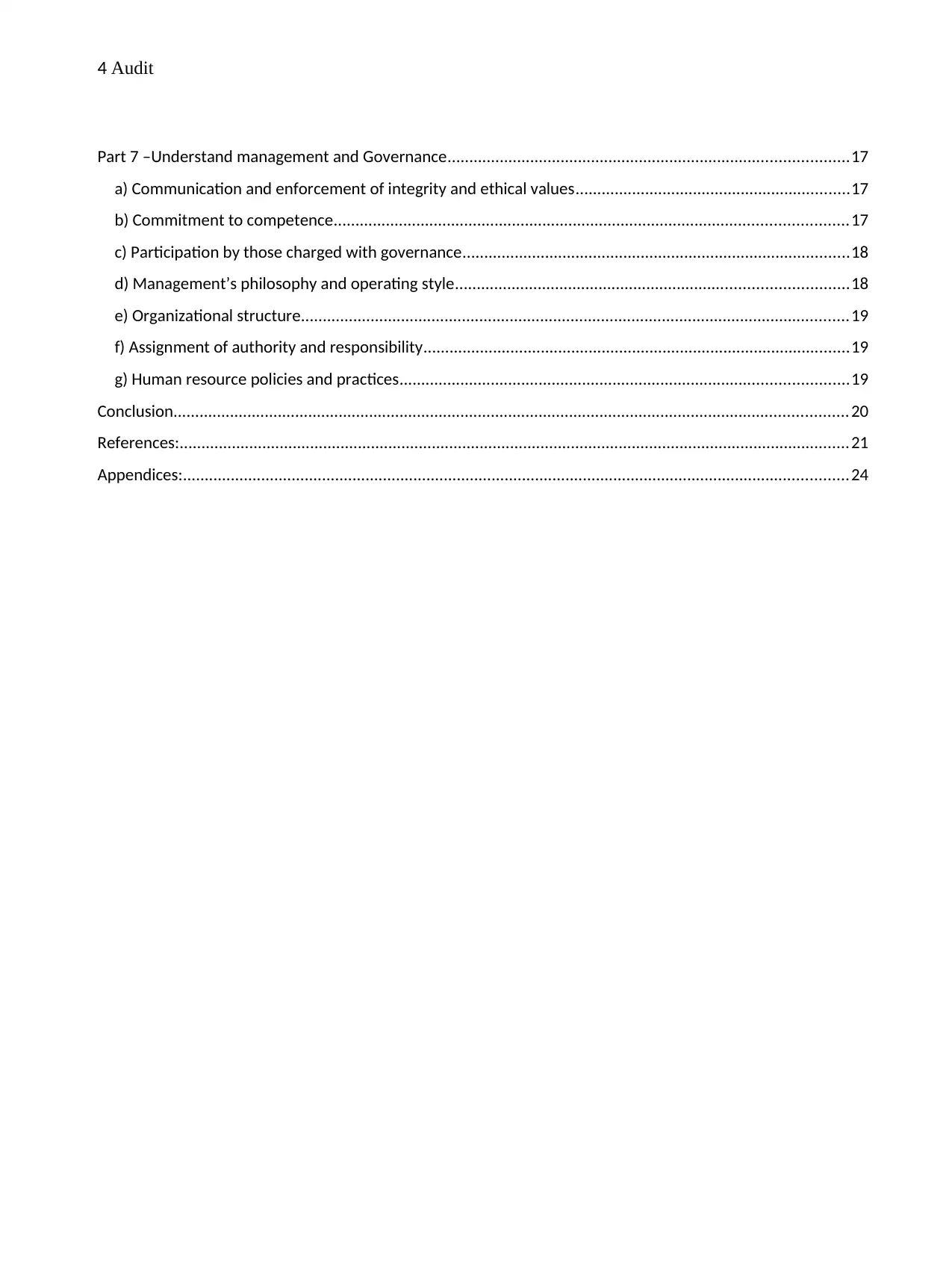
4 Audit
Part 7 –Understand management and Governance............................................................................................17
a) Communication and enforcement of integrity and ethical values...............................................................17
b) Commitment to competence......................................................................................................................17
c) Participation by those charged with governance.........................................................................................18
d) Management’s philosophy and operating style..........................................................................................18
e) Organizational structure..............................................................................................................................19
f) Assignment of authority and responsibility..................................................................................................19
g) Human resource policies and practices.......................................................................................................19
Conclusion...........................................................................................................................................................20
References:..........................................................................................................................................................21
Appendices:.........................................................................................................................................................24
Part 7 –Understand management and Governance............................................................................................17
a) Communication and enforcement of integrity and ethical values...............................................................17
b) Commitment to competence......................................................................................................................17
c) Participation by those charged with governance.........................................................................................18
d) Management’s philosophy and operating style..........................................................................................18
e) Organizational structure..............................................................................................................................19
f) Assignment of authority and responsibility..................................................................................................19
g) Human resource policies and practices.......................................................................................................19
Conclusion...........................................................................................................................................................20
References:..........................................................................................................................................................21
Appendices:.........................................................................................................................................................24
Paraphrase This Document
Need a fresh take? Get an instant paraphrase of this document with our AI Paraphraser
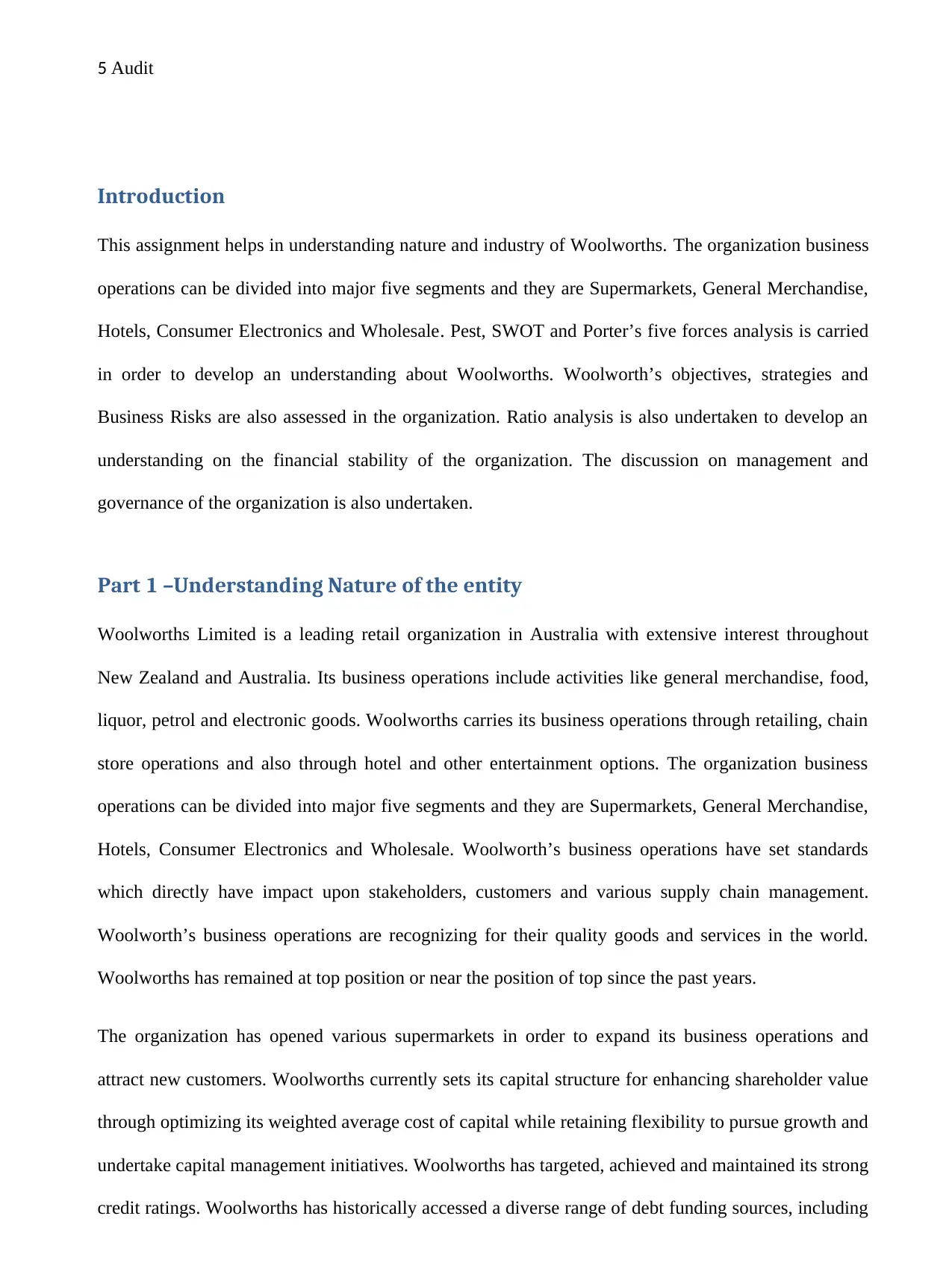
5 Audit
Introduction
This assignment helps in understanding nature and industry of Woolworths. The organization business
operations can be divided into major five segments and they are Supermarkets, General Merchandise,
Hotels, Consumer Electronics and Wholesale. Pest, SWOT and Porter’s five forces analysis is carried
in order to develop an understanding about Woolworths. Woolworth’s objectives, strategies and
Business Risks are also assessed in the organization. Ratio analysis is also undertaken to develop an
understanding on the financial stability of the organization. The discussion on management and
governance of the organization is also undertaken.
Part 1 –Understanding Nature of the entity
Woolworths Limited is a leading retail organization in Australia with extensive interest throughout
New Zealand and Australia. Its business operations include activities like general merchandise, food,
liquor, petrol and electronic goods. Woolworths carries its business operations through retailing, chain
store operations and also through hotel and other entertainment options. The organization business
operations can be divided into major five segments and they are Supermarkets, General Merchandise,
Hotels, Consumer Electronics and Wholesale. Woolworth’s business operations have set standards
which directly have impact upon stakeholders, customers and various supply chain management.
Woolworth’s business operations are recognizing for their quality goods and services in the world.
Woolworths has remained at top position or near the position of top since the past years.
The organization has opened various supermarkets in order to expand its business operations and
attract new customers. Woolworths currently sets its capital structure for enhancing shareholder value
through optimizing its weighted average cost of capital while retaining flexibility to pursue growth and
undertake capital management initiatives. Woolworths has targeted, achieved and maintained its strong
credit ratings. Woolworths has historically accessed a diverse range of debt funding sources, including
Introduction
This assignment helps in understanding nature and industry of Woolworths. The organization business
operations can be divided into major five segments and they are Supermarkets, General Merchandise,
Hotels, Consumer Electronics and Wholesale. Pest, SWOT and Porter’s five forces analysis is carried
in order to develop an understanding about Woolworths. Woolworth’s objectives, strategies and
Business Risks are also assessed in the organization. Ratio analysis is also undertaken to develop an
understanding on the financial stability of the organization. The discussion on management and
governance of the organization is also undertaken.
Part 1 –Understanding Nature of the entity
Woolworths Limited is a leading retail organization in Australia with extensive interest throughout
New Zealand and Australia. Its business operations include activities like general merchandise, food,
liquor, petrol and electronic goods. Woolworths carries its business operations through retailing, chain
store operations and also through hotel and other entertainment options. The organization business
operations can be divided into major five segments and they are Supermarkets, General Merchandise,
Hotels, Consumer Electronics and Wholesale. Woolworth’s business operations have set standards
which directly have impact upon stakeholders, customers and various supply chain management.
Woolworth’s business operations are recognizing for their quality goods and services in the world.
Woolworths has remained at top position or near the position of top since the past years.
The organization has opened various supermarkets in order to expand its business operations and
attract new customers. Woolworths currently sets its capital structure for enhancing shareholder value
through optimizing its weighted average cost of capital while retaining flexibility to pursue growth and
undertake capital management initiatives. Woolworths has targeted, achieved and maintained its strong
credit ratings. Woolworths has historically accessed a diverse range of debt funding sources, including
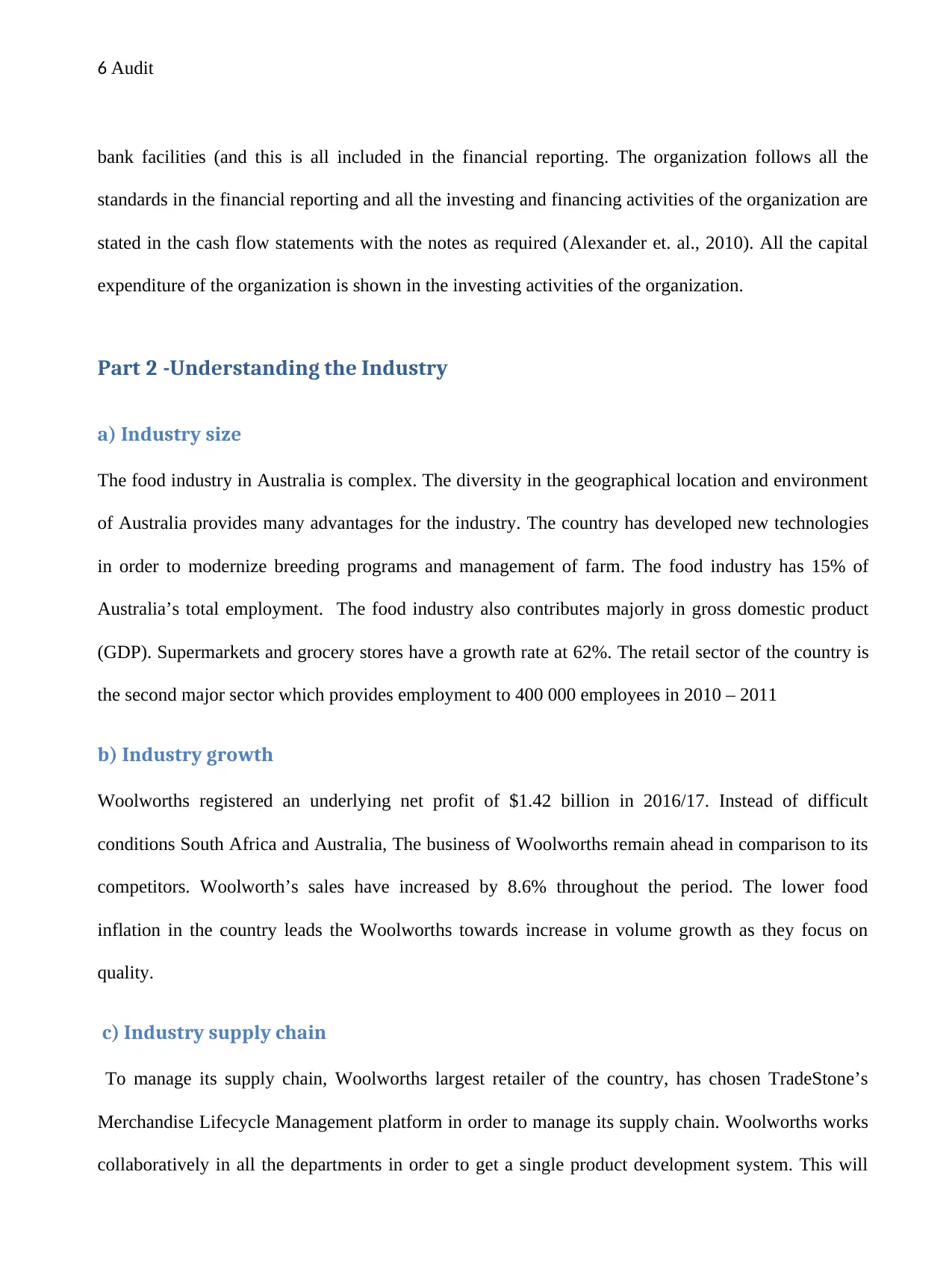
6 Audit
bank facilities (and this is all included in the financial reporting. The organization follows all the
standards in the financial reporting and all the investing and financing activities of the organization are
stated in the cash flow statements with the notes as required (Alexander et. al., 2010). All the capital
expenditure of the organization is shown in the investing activities of the organization.
Part 2 -Understanding the Industry
a) Industry size
The food industry in Australia is complex. The diversity in the geographical location and environment
of Australia provides many advantages for the industry. The country has developed new technologies
in order to modernize breeding programs and management of farm. The food industry has 15% of
Australia’s total employment. The food industry also contributes majorly in gross domestic product
(GDP). Supermarkets and grocery stores have a growth rate at 62%. The retail sector of the country is
the second major sector which provides employment to 400 000 employees in 2010 – 2011
b) Industry growth
Woolworths registered an underlying net profit of $1.42 billion in 2016/17. Instead of difficult
conditions South Africa and Australia, The business of Woolworths remain ahead in comparison to its
competitors. Woolworth’s sales have increased by 8.6% throughout the period. The lower food
inflation in the country leads the Woolworths towards increase in volume growth as they focus on
quality.
c) Industry supply chain
To manage its supply chain, Woolworths largest retailer of the country, has chosen TradeStone’s
Merchandise Lifecycle Management platform in order to manage its supply chain. Woolworths works
collaboratively in all the departments in order to get a single product development system. This will
bank facilities (and this is all included in the financial reporting. The organization follows all the
standards in the financial reporting and all the investing and financing activities of the organization are
stated in the cash flow statements with the notes as required (Alexander et. al., 2010). All the capital
expenditure of the organization is shown in the investing activities of the organization.
Part 2 -Understanding the Industry
a) Industry size
The food industry in Australia is complex. The diversity in the geographical location and environment
of Australia provides many advantages for the industry. The country has developed new technologies
in order to modernize breeding programs and management of farm. The food industry has 15% of
Australia’s total employment. The food industry also contributes majorly in gross domestic product
(GDP). Supermarkets and grocery stores have a growth rate at 62%. The retail sector of the country is
the second major sector which provides employment to 400 000 employees in 2010 – 2011
b) Industry growth
Woolworths registered an underlying net profit of $1.42 billion in 2016/17. Instead of difficult
conditions South Africa and Australia, The business of Woolworths remain ahead in comparison to its
competitors. Woolworth’s sales have increased by 8.6% throughout the period. The lower food
inflation in the country leads the Woolworths towards increase in volume growth as they focus on
quality.
c) Industry supply chain
To manage its supply chain, Woolworths largest retailer of the country, has chosen TradeStone’s
Merchandise Lifecycle Management platform in order to manage its supply chain. Woolworths works
collaboratively in all the departments in order to get a single product development system. This will
⊘ This is a preview!⊘
Do you want full access?
Subscribe today to unlock all pages.

Trusted by 1+ million students worldwide
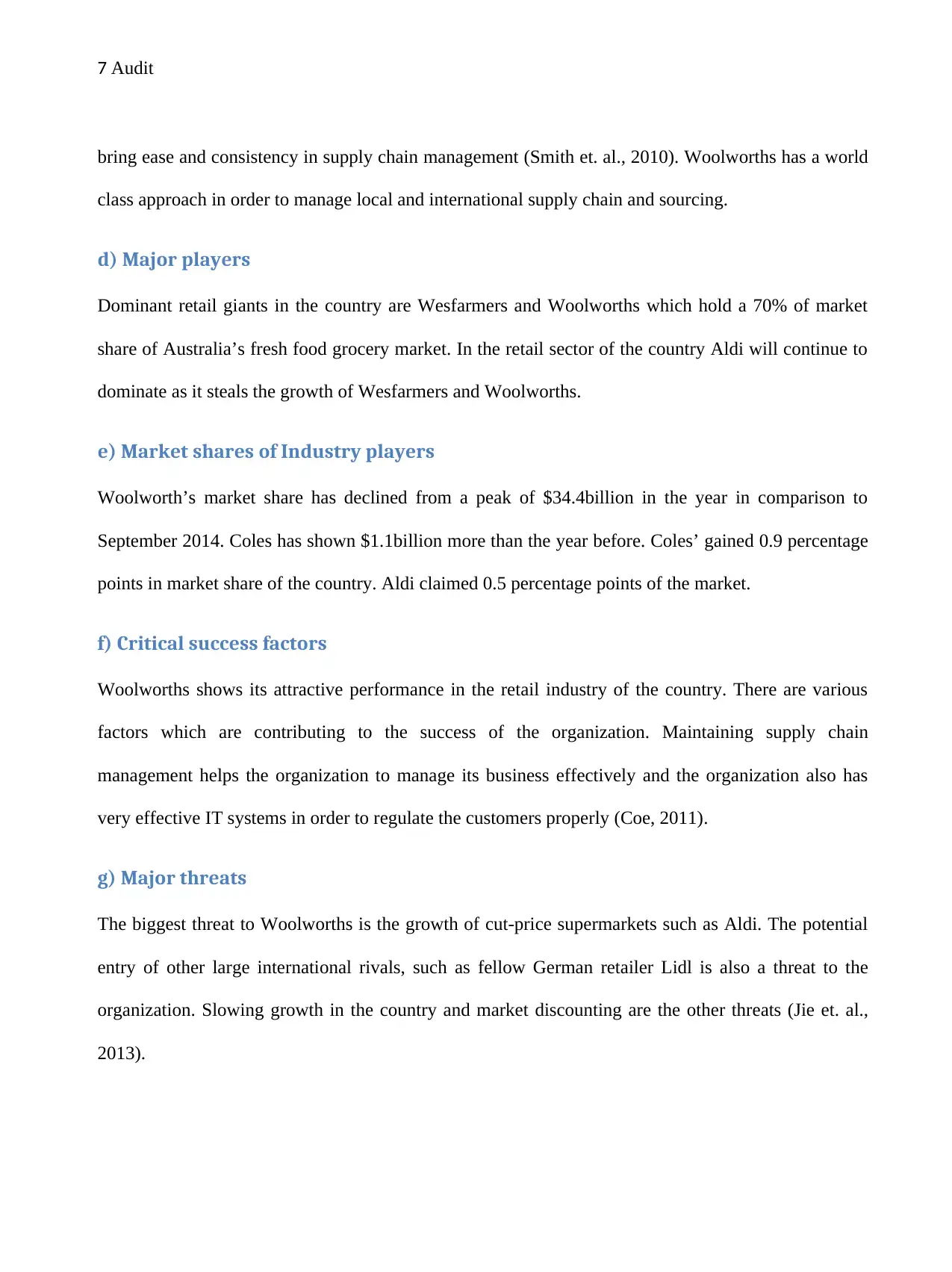
7 Audit
bring ease and consistency in supply chain management (Smith et. al., 2010). Woolworths has a world
class approach in order to manage local and international supply chain and sourcing.
d) Major players
Dominant retail giants in the country are Wesfarmers and Woolworths which hold a 70% of market
share of Australia’s fresh food grocery market. In the retail sector of the country Aldi will continue to
dominate as it steals the growth of Wesfarmers and Woolworths.
e) Market shares of Industry players
Woolworth’s market share has declined from a peak of $34.4billion in the year in comparison to
September 2014. Coles has shown $1.1billion more than the year before. Coles’ gained 0.9 percentage
points in market share of the country. Aldi claimed 0.5 percentage points of the market.
f) Critical success factors
Woolworths shows its attractive performance in the retail industry of the country. There are various
factors which are contributing to the success of the organization. Maintaining supply chain
management helps the organization to manage its business effectively and the organization also has
very effective IT systems in order to regulate the customers properly (Coe, 2011).
g) Major threats
The biggest threat to Woolworths is the growth of cut-price supermarkets such as Aldi. The potential
entry of other large international rivals, such as fellow German retailer Lidl is also a threat to the
organization. Slowing growth in the country and market discounting are the other threats (Jie et. al.,
2013).
bring ease and consistency in supply chain management (Smith et. al., 2010). Woolworths has a world
class approach in order to manage local and international supply chain and sourcing.
d) Major players
Dominant retail giants in the country are Wesfarmers and Woolworths which hold a 70% of market
share of Australia’s fresh food grocery market. In the retail sector of the country Aldi will continue to
dominate as it steals the growth of Wesfarmers and Woolworths.
e) Market shares of Industry players
Woolworth’s market share has declined from a peak of $34.4billion in the year in comparison to
September 2014. Coles has shown $1.1billion more than the year before. Coles’ gained 0.9 percentage
points in market share of the country. Aldi claimed 0.5 percentage points of the market.
f) Critical success factors
Woolworths shows its attractive performance in the retail industry of the country. There are various
factors which are contributing to the success of the organization. Maintaining supply chain
management helps the organization to manage its business effectively and the organization also has
very effective IT systems in order to regulate the customers properly (Coe, 2011).
g) Major threats
The biggest threat to Woolworths is the growth of cut-price supermarkets such as Aldi. The potential
entry of other large international rivals, such as fellow German retailer Lidl is also a threat to the
organization. Slowing growth in the country and market discounting are the other threats (Jie et. al.,
2013).
Paraphrase This Document
Need a fresh take? Get an instant paraphrase of this document with our AI Paraphraser
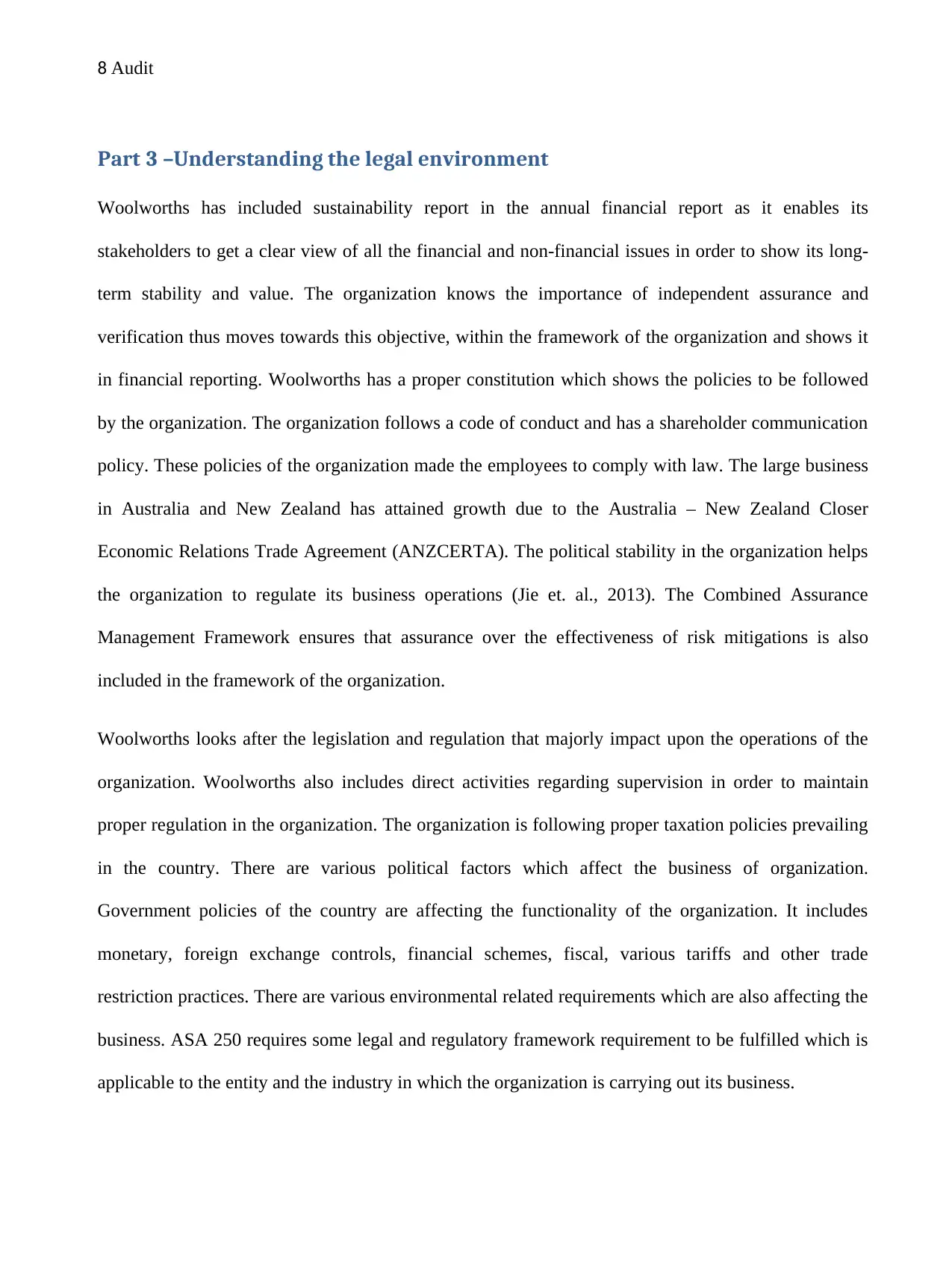
8 Audit
Part 3 –Understanding the legal environment
Woolworths has included sustainability report in the annual financial report as it enables its
stakeholders to get a clear view of all the financial and non-financial issues in order to show its long-
term stability and value. The organization knows the importance of independent assurance and
verification thus moves towards this objective, within the framework of the organization and shows it
in financial reporting. Woolworths has a proper constitution which shows the policies to be followed
by the organization. The organization follows a code of conduct and has a shareholder communication
policy. These policies of the organization made the employees to comply with law. The large business
in Australia and New Zealand has attained growth due to the Australia – New Zealand Closer
Economic Relations Trade Agreement (ANZCERTA). The political stability in the organization helps
the organization to regulate its business operations (Jie et. al., 2013). The Combined Assurance
Management Framework ensures that assurance over the effectiveness of risk mitigations is also
included in the framework of the organization.
Woolworths looks after the legislation and regulation that majorly impact upon the operations of the
organization. Woolworths also includes direct activities regarding supervision in order to maintain
proper regulation in the organization. The organization is following proper taxation policies prevailing
in the country. There are various political factors which affect the business of organization.
Government policies of the country are affecting the functionality of the organization. It includes
monetary, foreign exchange controls, financial schemes, fiscal, various tariffs and other trade
restriction practices. There are various environmental related requirements which are also affecting the
business. ASA 250 requires some legal and regulatory framework requirement to be fulfilled which is
applicable to the entity and the industry in which the organization is carrying out its business.
Part 3 –Understanding the legal environment
Woolworths has included sustainability report in the annual financial report as it enables its
stakeholders to get a clear view of all the financial and non-financial issues in order to show its long-
term stability and value. The organization knows the importance of independent assurance and
verification thus moves towards this objective, within the framework of the organization and shows it
in financial reporting. Woolworths has a proper constitution which shows the policies to be followed
by the organization. The organization follows a code of conduct and has a shareholder communication
policy. These policies of the organization made the employees to comply with law. The large business
in Australia and New Zealand has attained growth due to the Australia – New Zealand Closer
Economic Relations Trade Agreement (ANZCERTA). The political stability in the organization helps
the organization to regulate its business operations (Jie et. al., 2013). The Combined Assurance
Management Framework ensures that assurance over the effectiveness of risk mitigations is also
included in the framework of the organization.
Woolworths looks after the legislation and regulation that majorly impact upon the operations of the
organization. Woolworths also includes direct activities regarding supervision in order to maintain
proper regulation in the organization. The organization is following proper taxation policies prevailing
in the country. There are various political factors which affect the business of organization.
Government policies of the country are affecting the functionality of the organization. It includes
monetary, foreign exchange controls, financial schemes, fiscal, various tariffs and other trade
restriction practices. There are various environmental related requirements which are also affecting the
business. ASA 250 requires some legal and regulatory framework requirement to be fulfilled which is
applicable to the entity and the industry in which the organization is carrying out its business.
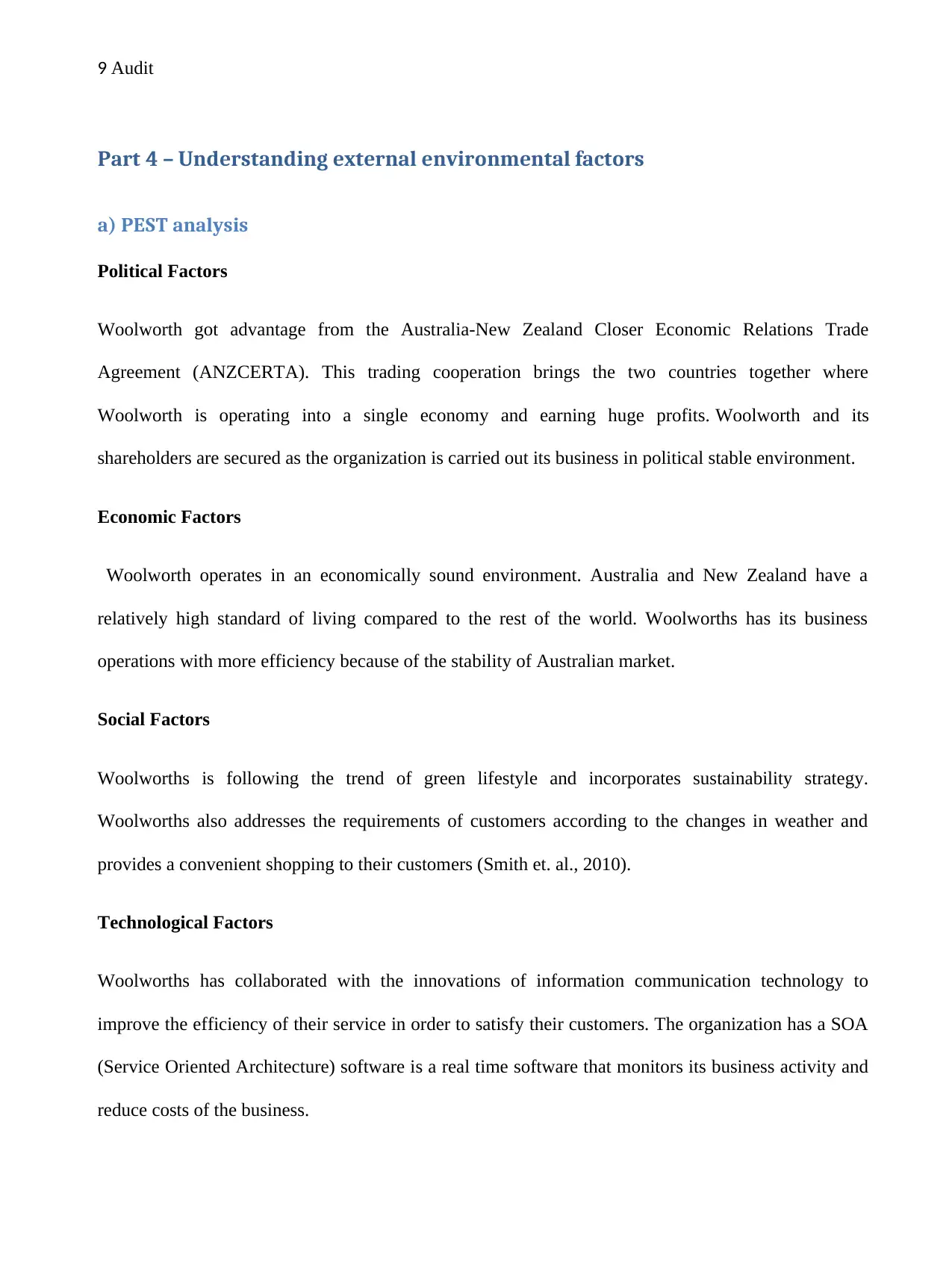
9 Audit
Part 4 – Understanding external environmental factors
a) PEST analysis
Political Factors
Woolworth got advantage from the Australia-New Zealand Closer Economic Relations Trade
Agreement (ANZCERTA). This trading cooperation brings the two countries together where
Woolworth is operating into a single economy and earning huge profits. Woolworth and its
shareholders are secured as the organization is carried out its business in political stable environment.
Economic Factors
Woolworth operates in an economically sound environment. Australia and New Zealand have a
relatively high standard of living compared to the rest of the world. Woolworths has its business
operations with more efficiency because of the stability of Australian market.
Social Factors
Woolworths is following the trend of green lifestyle and incorporates sustainability strategy.
Woolworths also addresses the requirements of customers according to the changes in weather and
provides a convenient shopping to their customers (Smith et. al., 2010).
Technological Factors
Woolworths has collaborated with the innovations of information communication technology to
improve the efficiency of their service in order to satisfy their customers. The organization has a SOA
(Service Oriented Architecture) software is a real time software that monitors its business activity and
reduce costs of the business.
Part 4 – Understanding external environmental factors
a) PEST analysis
Political Factors
Woolworth got advantage from the Australia-New Zealand Closer Economic Relations Trade
Agreement (ANZCERTA). This trading cooperation brings the two countries together where
Woolworth is operating into a single economy and earning huge profits. Woolworth and its
shareholders are secured as the organization is carried out its business in political stable environment.
Economic Factors
Woolworth operates in an economically sound environment. Australia and New Zealand have a
relatively high standard of living compared to the rest of the world. Woolworths has its business
operations with more efficiency because of the stability of Australian market.
Social Factors
Woolworths is following the trend of green lifestyle and incorporates sustainability strategy.
Woolworths also addresses the requirements of customers according to the changes in weather and
provides a convenient shopping to their customers (Smith et. al., 2010).
Technological Factors
Woolworths has collaborated with the innovations of information communication technology to
improve the efficiency of their service in order to satisfy their customers. The organization has a SOA
(Service Oriented Architecture) software is a real time software that monitors its business activity and
reduce costs of the business.
⊘ This is a preview!⊘
Do you want full access?
Subscribe today to unlock all pages.

Trusted by 1+ million students worldwide
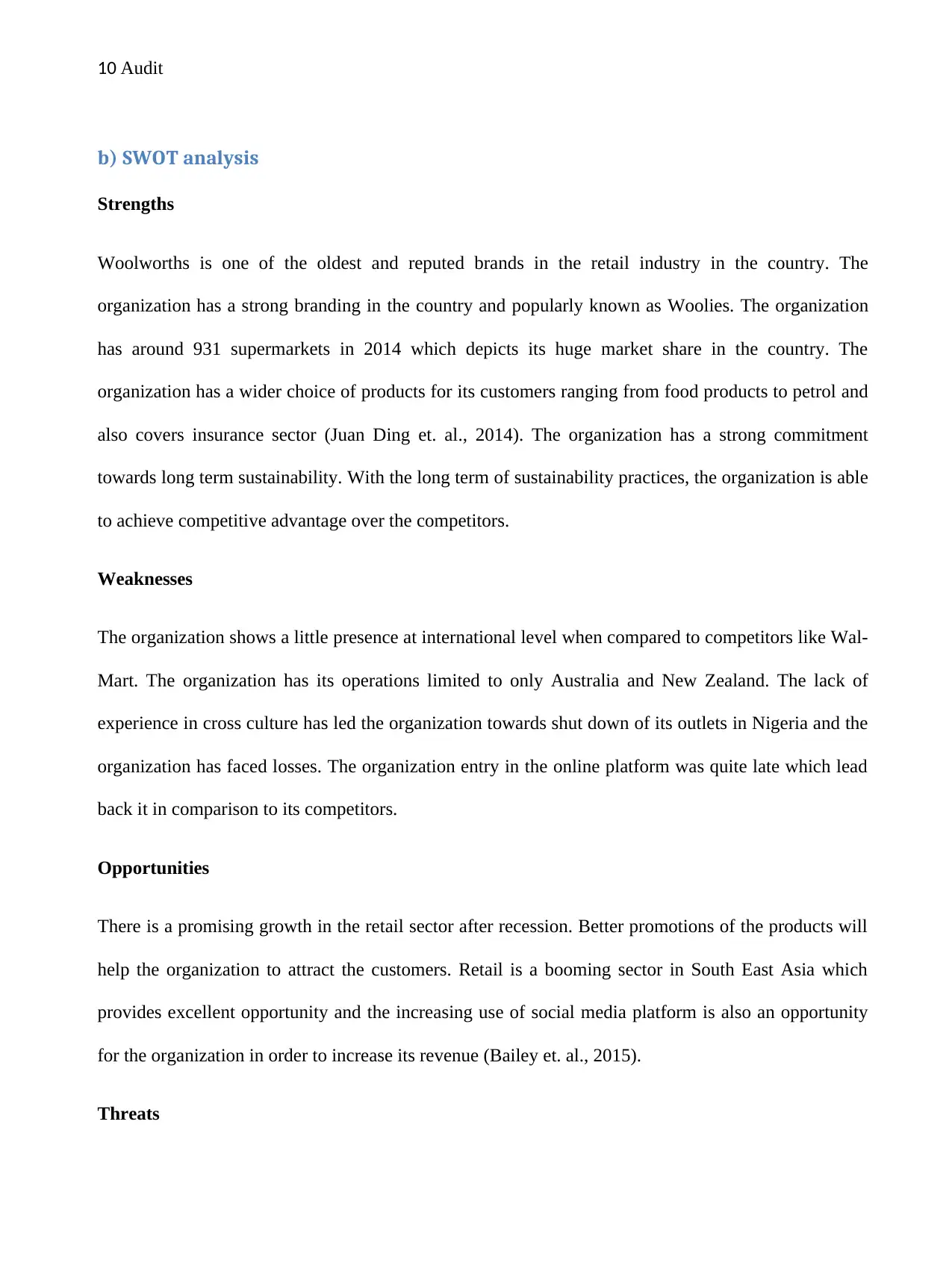
10 Audit
b) SWOT analysis
Strengths
Woolworths is one of the oldest and reputed brands in the retail industry in the country. The
organization has a strong branding in the country and popularly known as Woolies. The organization
has around 931 supermarkets in 2014 which depicts its huge market share in the country. The
organization has a wider choice of products for its customers ranging from food products to petrol and
also covers insurance sector (Juan Ding et. al., 2014). The organization has a strong commitment
towards long term sustainability. With the long term of sustainability practices, the organization is able
to achieve competitive advantage over the competitors.
Weaknesses
The organization shows a little presence at international level when compared to competitors like Wal-
Mart. The organization has its operations limited to only Australia and New Zealand. The lack of
experience in cross culture has led the organization towards shut down of its outlets in Nigeria and the
organization has faced losses. The organization entry in the online platform was quite late which lead
back it in comparison to its competitors.
Opportunities
There is a promising growth in the retail sector after recession. Better promotions of the products will
help the organization to attract the customers. Retail is a booming sector in South East Asia which
provides excellent opportunity and the increasing use of social media platform is also an opportunity
for the organization in order to increase its revenue (Bailey et. al., 2015).
Threats
b) SWOT analysis
Strengths
Woolworths is one of the oldest and reputed brands in the retail industry in the country. The
organization has a strong branding in the country and popularly known as Woolies. The organization
has around 931 supermarkets in 2014 which depicts its huge market share in the country. The
organization has a wider choice of products for its customers ranging from food products to petrol and
also covers insurance sector (Juan Ding et. al., 2014). The organization has a strong commitment
towards long term sustainability. With the long term of sustainability practices, the organization is able
to achieve competitive advantage over the competitors.
Weaknesses
The organization shows a little presence at international level when compared to competitors like Wal-
Mart. The organization has its operations limited to only Australia and New Zealand. The lack of
experience in cross culture has led the organization towards shut down of its outlets in Nigeria and the
organization has faced losses. The organization entry in the online platform was quite late which lead
back it in comparison to its competitors.
Opportunities
There is a promising growth in the retail sector after recession. Better promotions of the products will
help the organization to attract the customers. Retail is a booming sector in South East Asia which
provides excellent opportunity and the increasing use of social media platform is also an opportunity
for the organization in order to increase its revenue (Bailey et. al., 2015).
Threats
Paraphrase This Document
Need a fresh take? Get an instant paraphrase of this document with our AI Paraphraser
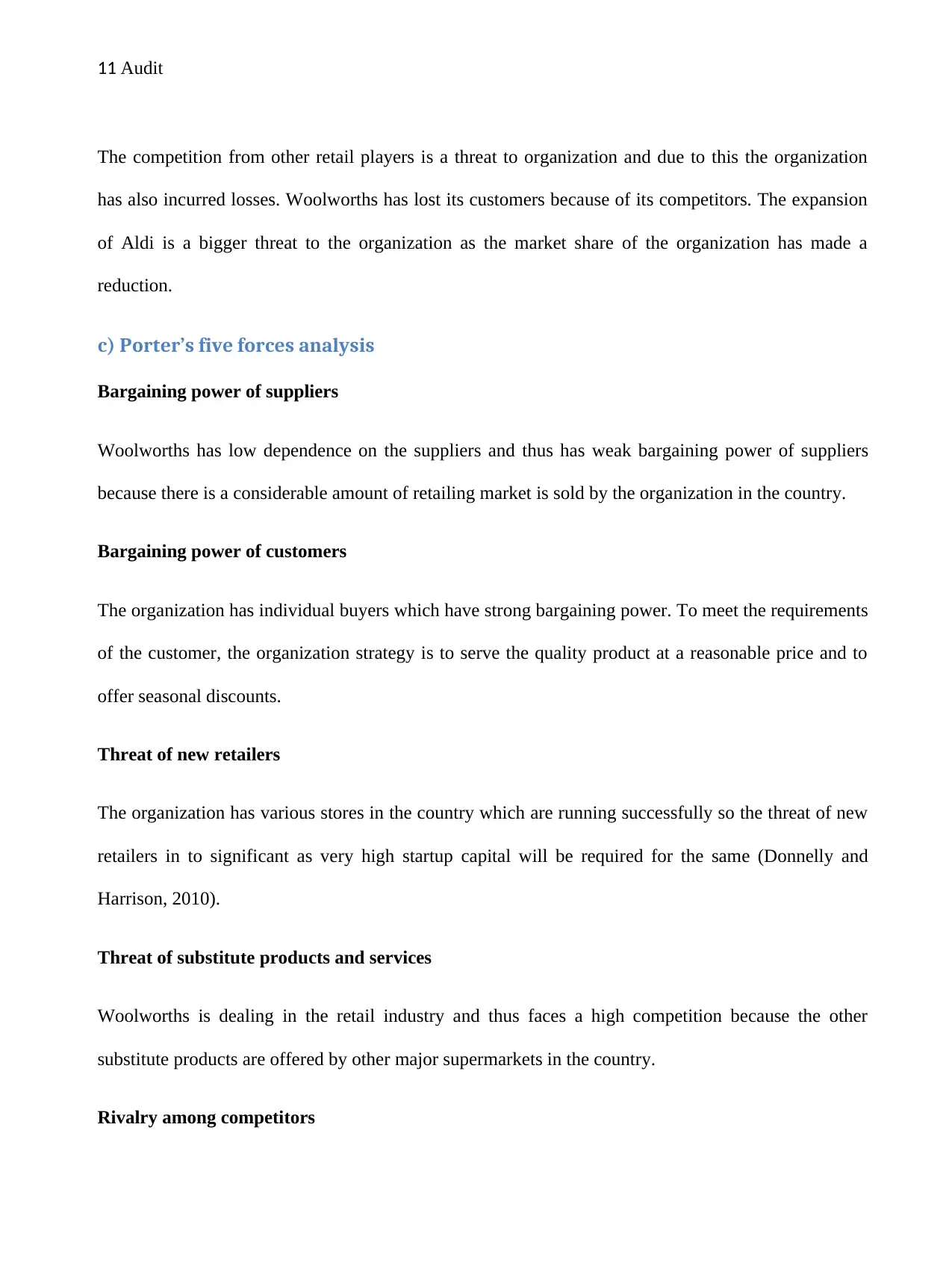
11 Audit
The competition from other retail players is a threat to organization and due to this the organization
has also incurred losses. Woolworths has lost its customers because of its competitors. The expansion
of Aldi is a bigger threat to the organization as the market share of the organization has made a
reduction.
c) Porter’s five forces analysis
Bargaining power of suppliers
Woolworths has low dependence on the suppliers and thus has weak bargaining power of suppliers
because there is a considerable amount of retailing market is sold by the organization in the country.
Bargaining power of customers
The organization has individual buyers which have strong bargaining power. To meet the requirements
of the customer, the organization strategy is to serve the quality product at a reasonable price and to
offer seasonal discounts.
Threat of new retailers
The organization has various stores in the country which are running successfully so the threat of new
retailers in to significant as very high startup capital will be required for the same (Donnelly and
Harrison, 2010).
Threat of substitute products and services
Woolworths is dealing in the retail industry and thus faces a high competition because the other
substitute products are offered by other major supermarkets in the country.
Rivalry among competitors
The competition from other retail players is a threat to organization and due to this the organization
has also incurred losses. Woolworths has lost its customers because of its competitors. The expansion
of Aldi is a bigger threat to the organization as the market share of the organization has made a
reduction.
c) Porter’s five forces analysis
Bargaining power of suppliers
Woolworths has low dependence on the suppliers and thus has weak bargaining power of suppliers
because there is a considerable amount of retailing market is sold by the organization in the country.
Bargaining power of customers
The organization has individual buyers which have strong bargaining power. To meet the requirements
of the customer, the organization strategy is to serve the quality product at a reasonable price and to
offer seasonal discounts.
Threat of new retailers
The organization has various stores in the country which are running successfully so the threat of new
retailers in to significant as very high startup capital will be required for the same (Donnelly and
Harrison, 2010).
Threat of substitute products and services
Woolworths is dealing in the retail industry and thus faces a high competition because the other
substitute products are offered by other major supermarkets in the country.
Rivalry among competitors
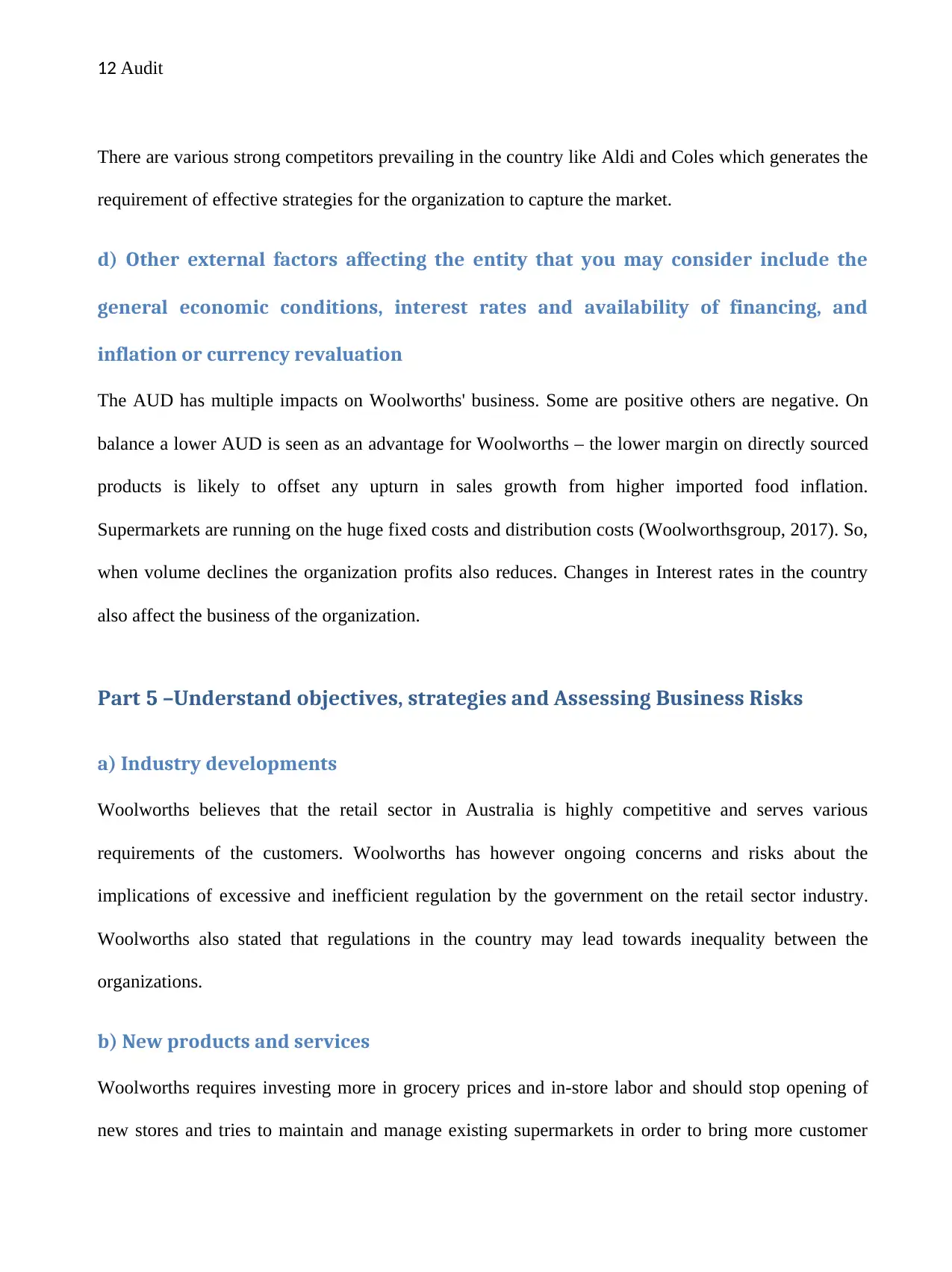
12 Audit
There are various strong competitors prevailing in the country like Aldi and Coles which generates the
requirement of effective strategies for the organization to capture the market.
d) Other external factors affecting the entity that you may consider include the
general economic conditions, interest rates and availability of financing, and
inflation or currency revaluation
The AUD has multiple impacts on Woolworths' business. Some are positive others are negative. On
balance a lower AUD is seen as an advantage for Woolworths – the lower margin on directly sourced
products is likely to offset any upturn in sales growth from higher imported food inflation.
Supermarkets are running on the huge fixed costs and distribution costs (Woolworthsgroup, 2017). So,
when volume declines the organization profits also reduces. Changes in Interest rates in the country
also affect the business of the organization.
Part 5 –Understand objectives, strategies and Assessing Business Risks
a) Industry developments
Woolworths believes that the retail sector in Australia is highly competitive and serves various
requirements of the customers. Woolworths has however ongoing concerns and risks about the
implications of excessive and inefficient regulation by the government on the retail sector industry.
Woolworths also stated that regulations in the country may lead towards inequality between the
organizations.
b) New products and services
Woolworths requires investing more in grocery prices and in-store labor and should stop opening of
new stores and tries to maintain and manage existing supermarkets in order to bring more customer
There are various strong competitors prevailing in the country like Aldi and Coles which generates the
requirement of effective strategies for the organization to capture the market.
d) Other external factors affecting the entity that you may consider include the
general economic conditions, interest rates and availability of financing, and
inflation or currency revaluation
The AUD has multiple impacts on Woolworths' business. Some are positive others are negative. On
balance a lower AUD is seen as an advantage for Woolworths – the lower margin on directly sourced
products is likely to offset any upturn in sales growth from higher imported food inflation.
Supermarkets are running on the huge fixed costs and distribution costs (Woolworthsgroup, 2017). So,
when volume declines the organization profits also reduces. Changes in Interest rates in the country
also affect the business of the organization.
Part 5 –Understand objectives, strategies and Assessing Business Risks
a) Industry developments
Woolworths believes that the retail sector in Australia is highly competitive and serves various
requirements of the customers. Woolworths has however ongoing concerns and risks about the
implications of excessive and inefficient regulation by the government on the retail sector industry.
Woolworths also stated that regulations in the country may lead towards inequality between the
organizations.
b) New products and services
Woolworths requires investing more in grocery prices and in-store labor and should stop opening of
new stores and tries to maintain and manage existing supermarkets in order to bring more customer
⊘ This is a preview!⊘
Do you want full access?
Subscribe today to unlock all pages.

Trusted by 1+ million students worldwide
1 out of 24
Related Documents
Your All-in-One AI-Powered Toolkit for Academic Success.
+13062052269
info@desklib.com
Available 24*7 on WhatsApp / Email
![[object Object]](/_next/static/media/star-bottom.7253800d.svg)
Unlock your academic potential
Copyright © 2020–2025 A2Z Services. All Rights Reserved. Developed and managed by ZUCOL.





